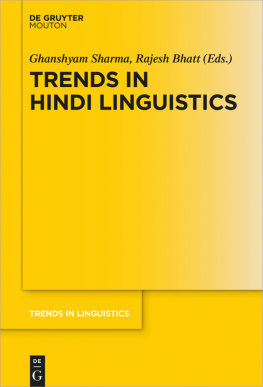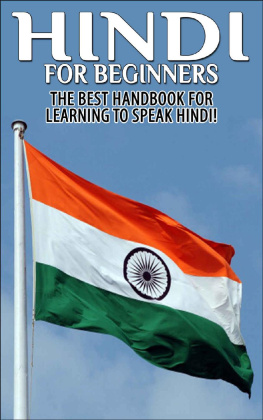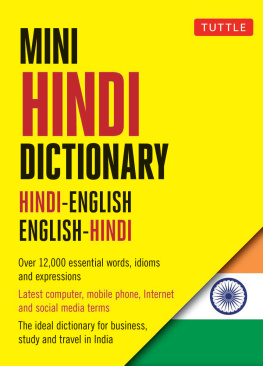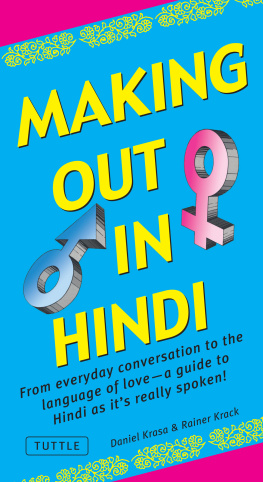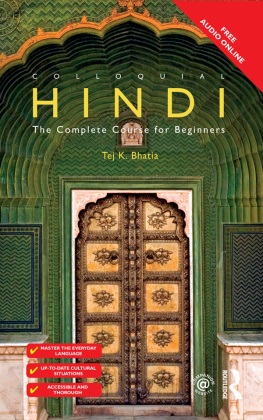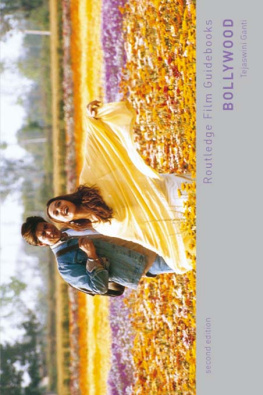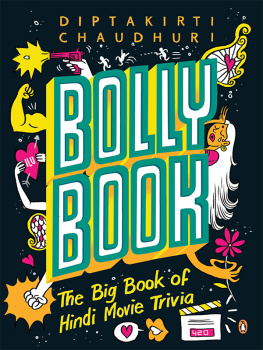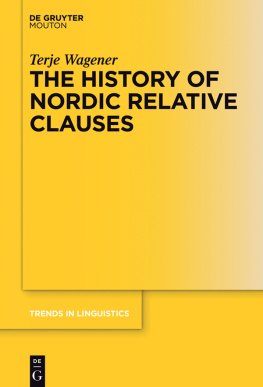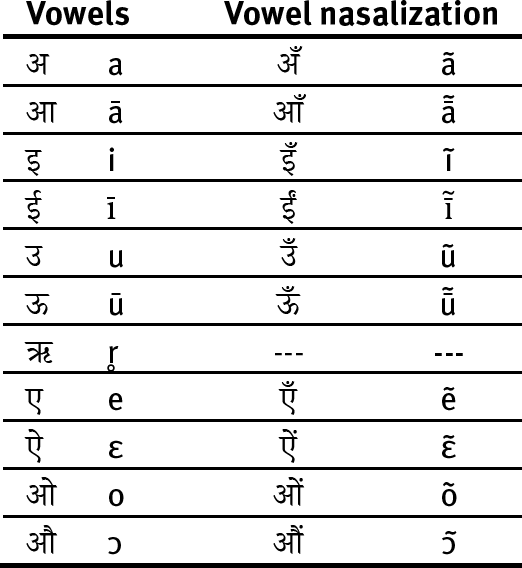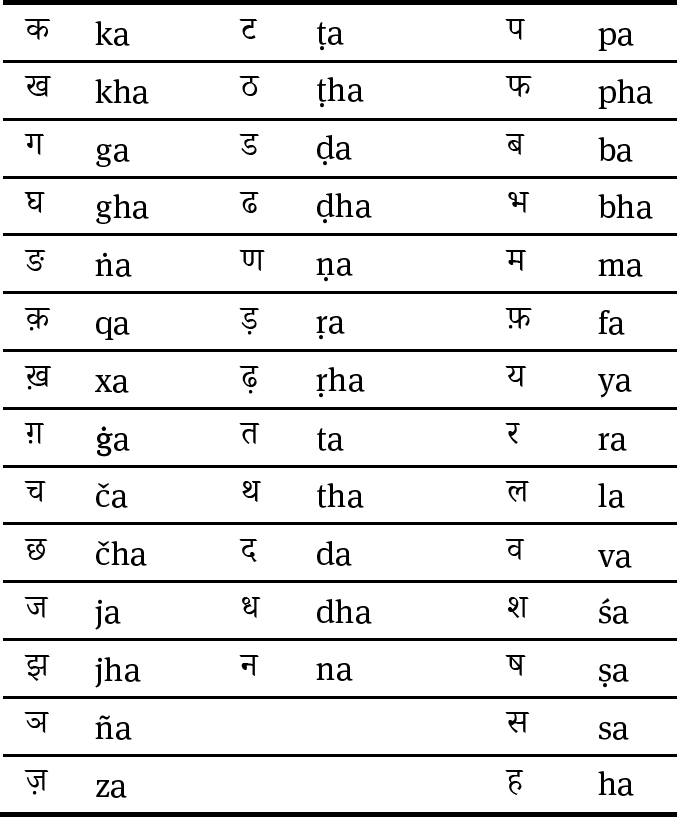Contents
Guide

Ghanshyam Sharma, Rajesh Bhatt (Eds.)
Trends in Hindi Linguistics
Trends in Linguistics Studies and Monographs

Editor
Volker Gast
Editorial Board
Walter Bisang
Hans Henrich Hock
Natalia Levshina
Heiko Narrog
Matthias Schlesewsky
Amir Zeldes
Niina Ning Zhang
Editor responsible for this volume
Hans Henrich Hock
Volume 325

ISBN 978-3-11-060698-0
e-ISBN (PDF) 978-3-11-061079-6
e-ISBN (EPUB) 978-3-11-060806-9
ISSN 1861-4302
Library of Congress Control Number: 2018955059
Bibliographic information published by the Deutsche Nationalbibliothek
The Deutsche Nationalbibliothek lists this publication in the Deutsche Nationalbibliografie; detailed bibliographic data are available on the Internet at http://dnb.dnb.de.
2018 Walter de Gruyter GmbH, Berlin/Boston
www.degruyter.com

To Annie Montaut
Preface
This volume grows out of a very unique gathering of linguists working on Hindi that was organized by the first editor at INALCO, Paris, from September 1416, 2016. The conference brought together linguists with a wide range of interests, backgrounds and methodologies and we hope that this volume will give the reader a taste of the depth, diversity, and progress that characterize contemporary work on Hindi and South Asian languages more generally. The bulk of the papers engage with questions in syntax and semantics but they do so with quite different research programs and they do so with different tools. What is beautiful is that this does not lead to conceptual incoherence; rather in the best argumentative tradition of the subcontinent, we have research that is deepened by the multiplicity of vantage points. To point out just a few of these dimensions, we have arguments from historical change (Montaut), detailed analysis of corpora (Kostina, Zakharyin), cross-linguistic variation (Hook & Koul), stylistic variation (Khoklova), and computational analysis of texts (Fatma).
The complex verbal structures of Hindi, their syntax and their semantics, have drawn the attention of linguists through the years and we are happy to report that they have not lost their allure. The papers by Manetta, Montaut, Kostina, Das, Fatma, and Drocco all deal with various aspects of Hindi verbal structures. Manettas paper introduces a new line of attack by using arguments from Verb Phrase Ellipsis to argue for particular structures and in doing so it also establishes a place for Verb Phrase Ellipsis in the grammar of Hindi. The question of participial relative clauses receives attention from Zakharyin and Mahajan. Zakharyin discusses pragmatic restrictions on the availability of participial relativization while Mahajan presents us with a case based analysis of participle relatives in Hindi.
In addition to new approaches to the classic phenomena of Hindi grammar, several authors introduce new questions. The paper by Dayal which kicks off the volume examines the semantics of bare nominal expressions in Hindi and provides us with a set of diagnostics that tell us that the naive idea that they are just underdetermined with respect to definiteness is incorrect. Instead we are given a picture where indefiniteness has structural correlates but definiteness may not. The paper sets up a program of research in cross-linguistic semantics and has implications for second language acquisition. Another new angle is brought up by the Hook & Koul contribution which gives us a way forward on a mystery of Hindi syntaxpredicates which behave intransitively despite the presence of transitive verb kar to do. In the best traditions of cross-linguistic work, they note that the corresponding structures in Kashmiri have an expletive exponent; an observation that makes the exceptional behavior of the Hindi cases less mysterious. We would like to thank Professor Hans Heinrich Hock for his help in editing the volume. We would also like this occasion to note with sorrow the death of two eminent Hindi linguists: Professor Alice Davison and Professor Omkar Koul. Professor Davison was looking forward to attending the meeting in Paris and anonymously reviewed two of the articles in this volume. Unfortunately, she could not make it to the conference. Professor Koul passed away while this volume was being completed. Their passing is a big loss to the field. We feel grateful that they were both involved in this volume, Professor Davison through her reviewing and Professor Koul through his co-authored paper.
Ghanshyam Sharma
Rajesh Bhatt
Acknowledgements
The present volume contains some of the peer-reviewed papers presented at the International conference on Hindi studies organized by Ghanshyam Sharma at the Institut national des langues et civilisations orientales ( INALCO ) in Paris on September 1416, 2016. The conference was organized under the auspices of the Indian Ministry of Foreign Affairs, Delhi and the Embassy of India in Paris. We would like to thank all the authorities in Delhi and Paris who lent their full support to the organization of the conference.
We are also grateful to the authorities at the following institution who provided generous financial support to organize the Hindi conference in Paris.
Institut national des langues et civilisations orientales ( INALCO ), Paris
Mondes iranien et indien (UMR-7528), Paris
Laboratoire dexcellence Empirical Foundation of Linguistics, Paris
Last but not least, we are deeply indebted to Professor Hans Henrich Hock for his personal interest in the project of bringing out the present volume in the Mouton de Gruyters series TiLSM. Not only did he welcome our proposal to publish the volume with Mouton, he has been supportive at every stage of this project: Thank you!
Transliteration
In order to ensure consistency in transliteration, a slightly modified version of the Sanskrit method is used to transliterate the Hindi examples used in this volume.
Tab. 1: Devanagari transliteration method used in the book
Consonants
Veneeta Dayal
(In)definiteness without articles: diagnosis, analysis, implications
Veneeta Dayal, Rutgers University, Department of Linguistics, 18 Seminary Place, NJ 08901, USA, phone: (848)-932-0477. Email:
Abstract: This paper addresses the view that bare nominals in languages without articles can be definites as well as indefinites. In particular, it challenges the status of bare nominals as indefinites, providing contexts in which English uses the indefinite article but an article-less language like Hindi must resort to a numeral construction. The empirical generalization based on Hindi is that bare nominals are ambiguous between definites and kind terms and that bare plurals, but not bare singulars, can have kind derived indefinite readings. The indefinite readings available to bare singulars must be traced to external factors. The paper then provides an explanation for these facts within a Neo-Carlsonian approach to bare nominals, addressing the issue of null determiners vs covert type shifts. The last section of the paper extends the insights gained from the case study of Hindi bare nominals to other languages, highlighting empirical and theoretical issues of relevance in determining whether bare nominals in a given language are definites or indefinites. It also comments on the well-established fact that adult learners of a language like English have trouble with the determiner system if their L1 does not have articles, from the vantage point of the findings about Hindi bare nominals.

